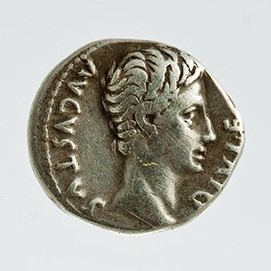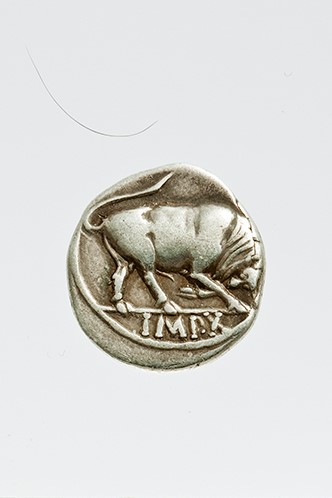Title: Denarius of Augustus - 1968.04
Acquisition number: 1968.04
Author or editor: Beryl Rawson
Culture or period: Roman Imperial
Date: 15-12 BC
Material: Metal - Silver
Object type: Coins - Roman
Dimensions: 19mm (w)
Origin region or location: France
Origin city: Lugdunum
Display case or on loan: 5
Keywords: Coin, denarius, Roman, Imperial, Augustus, Gaul, Lugdunum, Roman Gaul
Sear, D.R., Roman Coins and their Values 5 vols (London, Spink, 2000-2014) 1610; Mattingly, H.,Coins of the Roman Empire in the British Museum, 6 vols (London, 1965) 451; Seaby, H.A., Roman Silver Coins (London, B.A. Seaby, 1967) 137 (Lugdunum, 15-13 BC; RIC 167a; Giard, J.-P., Catalogue des Monnaies de l’Empire Romain 3 vols (Paris: Bibliothèque Nationale, 1988-1998) 1373.
1968.04
Denarius of Augustus
3.708 g. 15-12 BC
Obv.: Head of Augustus r., bare, with wavy hair close to head. AVGVSTUS DIVI F(ilius).
Rev.: Bull, head down, charging r. In exergue, IMP(erator) X.
This coin is probably one of the large issue from Gaul after Augustus established a mint for gold and silver at Lugdunum (Lyons) in 15 BC.
Augustus was acclaimed imperator for the tenth time in 15 BC and for the eleventh in 12 BC. The victories in 15 BC were won by Augustus’ step-son Drusus against the Germans (cf. Horace Odes 4.4).
The bull type was borrowed from coins of Thurii, a Greek colony in southern Italy associated with Augustus’ family origins (Suetonius Augustus 7). It was one of a number of Augustan types copied by Vespasian. Vespasian took Augustus as his model in many ways, one of them being the role of ‘bringer of Peace’. Both Vespasian and his son Titus used the bull type in AD 75, the year of dedication of the Temple of Peace.
Sear, D.R., Roman Coins and their Values 5 vols (London, Spink, 2000-2014) 1610; Mattingly, H.,Coins of the Roman Empire in the British Museum, 6 vols (London, 1965) 451; Seaby, H.A., Roman Silver Coins (London, B.A. Seaby, 1967) 137 (Lugdunum, 15-13 BC; RIC 167a; Giard, J.-P., Catalogue des Monnaies de l’Empire Romain 3 vols (Paris: Bibliothèque Nationale, 1988-1998) 1373.

